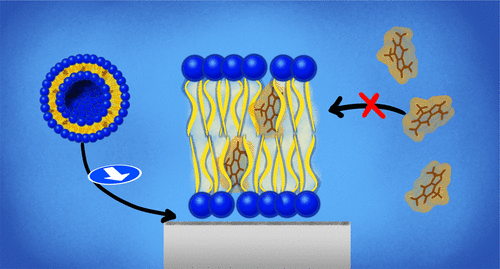当前位置:
X-MOL 学术
›
J. Phys. Chem. B
›
论文详情
Our official English website, www.x-mol.net, welcomes your
feedback! (Note: you will need to create a separate account there.)
Interaction of Caffeine with Model Lipid Membranes
The Journal of Physical Chemistry B ( IF 2.8 ) Pub Date : 2021-09-01 , DOI: 10.1021/acs.jpcb.1c04360 Letizia Tavagnacco 1 , Giacomo Corucci 2 , Yuri Gerelli 3
The Journal of Physical Chemistry B ( IF 2.8 ) Pub Date : 2021-09-01 , DOI: 10.1021/acs.jpcb.1c04360 Letizia Tavagnacco 1 , Giacomo Corucci 2 , Yuri Gerelli 3
Affiliation

|
Caffeine is not only a widely consumed active stimulant, but it is also a model molecule commonly used in pharmaceutical sciences. In this work, by performing quartz–crystal microbalance and neutron reflectometry experiments we investigate the interaction of caffeine molecules with a model lipid membrane. We determined that caffeine molecules are not able to spontaneously partition from an aqueous environment, enriched in caffeine, into a bilayer. Caffeine could be however included in solid-supported lipid bilayers if present with lipids during self-assembly. In this case, thanks to surface-sensitive techniques, we determined that caffeine molecules are preferentially located in the hydrophobic region of the membrane. These results are highly relevant for the development of new drug delivery vectors, as well as for a deeper understanding of the membrane permeation role of purine molecules.
中文翻译:

咖啡因与模型脂质膜的相互作用
咖啡因不仅是一种广泛消耗的活性兴奋剂,而且还是制药科学中常用的模型分子。在这项工作中,通过执行石英晶体微天平和中子反射计实验,我们研究了咖啡因分子与模型脂质膜的相互作用。我们确定咖啡因分子不能自发地从富含咖啡因的水性环境中分配到双层中。然而,如果在自组装过程中与脂质一起存在,则咖啡因可以包含在固体支持的脂质双层中。在这种情况下,由于表面敏感技术,我们确定咖啡因分子优先位于膜的疏水区域。这些结果与开发新的药物递送载体高度相关,
更新日期:2021-09-16
中文翻译:

咖啡因与模型脂质膜的相互作用
咖啡因不仅是一种广泛消耗的活性兴奋剂,而且还是制药科学中常用的模型分子。在这项工作中,通过执行石英晶体微天平和中子反射计实验,我们研究了咖啡因分子与模型脂质膜的相互作用。我们确定咖啡因分子不能自发地从富含咖啡因的水性环境中分配到双层中。然而,如果在自组装过程中与脂质一起存在,则咖啡因可以包含在固体支持的脂质双层中。在这种情况下,由于表面敏感技术,我们确定咖啡因分子优先位于膜的疏水区域。这些结果与开发新的药物递送载体高度相关,











































 京公网安备 11010802027423号
京公网安备 11010802027423号